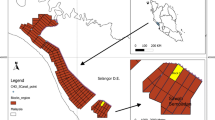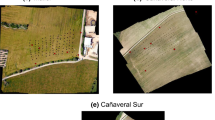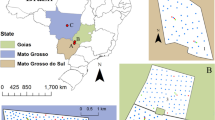Abstract
The development and the release of sensors capable of providing data with high spatial resolution (> 4 000 points ha−1) in agriculture raises new questions as to how to represent this spatial information. The objective of this study was to propose a methodology to help define the optimal grid size to map high resolution data in agriculture. The geostatistical method finds the grid size which maximizes the sum of two components: (i) the proportion of nugget variance that is removed, and (ii) the proportion of sill variance that remains in the data. The optimum grid size was found to be dependent on the resolution of the available information and the spatial structure of the raw data. Experiments on simulated datasets with varying data resolution (from 500 to 2 000 pts.ha−1) and spatial structure (range of variogram between 10 and 45 m) showed that the proposed methodology was able to define varying optimal grid sizes (from 5 to 12 m). The proposed geostatistical approach was then applied on a real dataset of total soluble solids/sugar content of table grape so that the optimal mapping grid size could be found. Once it was defined, two interpolation methods: simple averaging over blocks and block kriging, were applied to mapping the data. Results show that both methods help depict the within-field variability in the data. While the averaging procedure is easier to automate, the block kriging approach provides users with a level of uncertainty in the aggregated data. Both mapping approaches significantly impacted the within-field spatial structure: (i) the small-scale variations were ten times lower than in the raw data, and (ii) the signal-to-noise ratio of the aggregated data with the optimal grid was twice as high as that of the raw data. As the proposed geostatistical methodology is a first attempt to define the optimal grid size to map high resolution spatial data, areas for future development applications are also proposed.






Similar content being viewed by others
References
Acevedo-Opazo, C., Tisseyre, B., Guillaume, S., & Ojeda, H. (2008). The potential of high spatial resolution information to define within-vineyard zones related to vine water status. Precision Agriculture, 9(5), 285–302.
Baluja, J., Diago, M., Goovaerts, P., & Tardaguila, J. (2012). Assessment of the spatial variability of anthocyanins in grapes using a fluorescence sensor: relationships with vine vigour and yield. Precision Agriculture, 13, 457–472.
Bellehumeur, C., Legendre, P., & Marcotte, D. (1997). Variance and spatial scales in a tropical rain forest: Changing the size of sampling units. Plant Ecology, 130, 89–98.
Bivand, R. S., Pebesma, E. J., & Gomez-Rubio, V. (2008). Applied spatial data analysis with R. New York, USA: Springer.
Blackmore, S., Godwin, R. J., & Fountas, S. (2003). The analysis of spatial and temporal trends in yield map data over six years. Biosystems Engineering, 84(4), 455–466.
Bramley, R. G. V., Trought, M. C. T., & Praat, J. P. (2011). Vineyard variability in Marlborough, New Zealand: Characterizing variation. Australian Journal of Grape and Wine Research, 17, 72–78.
Cambardella, C. A., Moorman, T. B., Novak, J. M., Parkin, T. B., Karlen, D. L., Turco, R. F., et al. (1994). Field-scale variability of soil properties in central Iowa soils. Soil Science Society of America Journal, 58, 1501–1511.
Cressie, N. (1996). Change of support and the modifiable areal unit proble. Geographical Systems, 3, 159–180.
Debuisson, S., Germain, C., Garcia, O., Panigai, L., Moncomble, D., Le Moigne, et al. (2010). Using Multiplex® and Greenseeker™ to manage spatial variation of vine vigor in Champagne. In 10th International Conference on Precision Agriculture. https://www.ispag.org/proceedings/?action=year_abstracts. Accessed 9 March, 2018.
Goovaerts, P. (1997). Geostatistics for natural resources evaluation. Applied geostatistics. New York, USA: Oxford University Press.
Journel, A. G., & Huijbregts, C. J. (1978). Mining geostatistics. London, England: Academic Press.
Lauzon, J. D., Fallow, D. J., O’Halloran, I. P., Gregory, S. D. L., & von Bertoldi, A. P. (2005). Assessing the temporal stability of spatial patterns in crop yields using combine yield monitor data. Canadian Journal of Soil Science, 85(3), 439–451.
Li, Y., Shi, Z., Wu, C.-F., Li, H.-Y., & Li, F. (2008). Determination of potential management zones from soil electrical conductivity, yield and crop data. Journal of Zheijang University, 9, 68–76.
R Core Team. (2017). R: A language and environment for statistical computing. Vienna, Austria: R Foundation for Statistical Computing. http://www.R-project.org/.
Serrano, J. M., Peça, J. O., Marques da Silva, J. R., & Shahidian, S. (2010). Mapping soil and pasture variability with an electromagnetic induction sensor. Computers and Electronic in Agriculture, 73(1), 7–16.
Tagarakis, A., Liakos, V., Fountas, S., Koundouras, S., & Gemtos, T. A. (2013). Management zones delineation using fuzzy clustering techniques in grapevines. Precision Agriculture, 14, 18–39.
Taylor, J., Acevedo-Opazo, C., Ojeda, H., & Tisseyre, B. (2010). Identification and significance of sources of spatial variation in grapevine water status. Australian Journal of Vine and Wine Research, 16, 218–226.
Taylor, J., Tisseyre, B., Bramley, R., & Reid, A. (2005). A comparison of the spatial variability of vineyard yield in European and Australian production systems. In: Stafford, J. V. (Ed.), Proceedings of the 4th European Conference on Precision Agriculture. The Netherlands: Wageningen Academic Publishers, pp 907–914.
Tisseyre, B., & McBratney, A. B. (2008). A technical opportunity index based on mathematical morphology for site-specific management using yield monitor data : application to viticulture. Precision Agriculture, 9(1–2), 101–113.
Weisstein, E. W. (2002) “Lambert W-function,” MathWorld, A Wolfram Web Resource., http://mathworld.wolfram.com/LambertW-Function.html. Accessed 10 August, 2017
Author information
Authors and Affiliations
Corresponding author
Rights and permissions
About this article
Cite this article
Tisseyre, B., Leroux, C., Pichon, L. et al. How to define the optimal grid size to map high resolution spatial data?. Precision Agric 19, 957–971 (2018). https://doi.org/10.1007/s11119-018-9566-5
Published:
Issue Date:
DOI: https://doi.org/10.1007/s11119-018-9566-5




